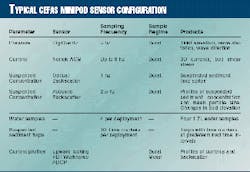HIGH ON THE AGENDA FOR any decommissioning project is establishing the environmental impact from the legacy of contaminated cuttings piles around platforms.
Before any decision on the possible solution options can be made, data on the size, character, sediment mobility, and contaminant history of the sediment has to be collected. These data can then be used to model likely fate and dispersion of soluble and particulate contaminants and inform decisions on cuttings pile options.
However, the close proximity of the cuttings piles to the platform makes collecting these data difficult. One option is to use research vessels with dynamic positioning, but this can be expensive.
Another problem is to ensure that the measurements of currents and suspended sediment concentration are taken close to the seabed, because it is there that many seabed sediment processes act. Traditional oceanographic instruments such as acoustic Doppler current profilers cannot measure close to the seabed or they cause significant flow disturbance, for example, current meters.
The U.K.'s Centre of Environment, Fisheries & Aquaculture Sciences (Cefas), Lowestoft, U.K., has developed a number of flexible seabed landers (Minipods) to overcome these problems.
The Minipod, which can deployed for up to 2 months, takes automated in situ measurements of near seabed processes to provide long-term sediment transport information.
Minipod
The Minipod consists of a flexible logging system and sensors mounted on a frame designed to minimize flow disturbance.
While many loggers are capable of measuring spot values of suspended sediment concentration using optical sensors, anthropogenic disturbance mechanisms are often very short term in character (e.g., beam-trawling, dredging, shipping activity), so these "snapshot" loggers can miss events.
The Minipod logger has been developed to collect long bursts of data at sample intervals up to 5 hz, typically for 12 min every 30 min for periods up to 2 months.
Duty cycles can be increased to virtually continuous, in order to catch all events. This sensor suite and sampling regime makes it possible to distinguish between natural (storms, tidal surges, etc.) and anthropogenic (ships, accidental spills, dredgers) events.
The Minipod system (see photograph) can log a variety of sensors (Table), measuring the tide and wave regime as well as the suspended sediment climate (the suspended load and particle size composition).
The suspended sediment climate is monitored using two approaches-optical and acoustic. The infrared optical sensors are most sensitive to fine particles in suspension (muds) whereas the acoustic sensor is most sensitive to sands in suspension.
The acoustic backscatter system (ABS) uses a two-frequency (1 and 4.5 Mhz) profiling system, giving suspended sediment profiles in 1 cm bins from the seabed to about 80 cm.
As two frequencies are used, an estimation of the mean particle size composition can be obtained. Short (about 1 min) and long (about 14 days) variations in seabed elevation due to ripples and consolidation, for example, can be observed from the ABS.
Both the currents and suspended sediment concentrations can be measured nonintrusively from the sensor platform. The Nortek Vector current meter can measure three current components at high sampling frequencies producing estimates of bed-shear stresses using both the energy-dissipation and Reynolds stress techniques.
The optical and acoustic backscatter sensors are calibrated in situ by using gravimetric and particle size data from a four-water sampler taken by the Minipod. Further calibrations can be obtained by using sediments caught in a timed sediment trap in a turbidity tank on return to the laboratory. Continuous particle size information is obtained using the Sequoia LISST25 particle analyzer.
A recent deployment of a Minipod on the cuttings pile of Fulmar Alpha platform (maximum elevation 8 m above the surrounding seabed datum) sponsored by Shell Global Solutions has shown the dynamic nature of the cuttings material of the pile and complex flow regime.
The results will form part of the wider investigations being undertaken by the U.K. Offshore Operators Association Drill Cuttings Initiative to improve understanding of pile behavior the and most suitable solution options.
Other uses
The Minipod system (and a new smaller logger called Micrologger) can also be used to monitor the sediment transport around structures, e.g., scour around platforms, free-spans, and emergence or burial of pipelines or mats.
It can also be used to measure currents close to the seabed for placement of templates or subsea valves, and for long-term monitoring of the sediment climate (suspended sediment concentration and particle size) for cooling intakes.
The Minipod is just one of a portfolio of projects under way at Cefas involving the design, manufacture, and deployment of a range of specialist underwater instrumentation for marine environmental measurements.
Another example is a miniature, robust, combined data logger and sensor developed for underwater use, which is being used to monitor pipeline temperatures in the North Sea.
A third, the smart mooring, is a moored observational platform that can measure temporal variability in physical, chemical, and biological parameters near the water surface, which is being deployed in a number of projects following successful field trials in North Sea.
The Author
Jon Rees received an engineering degree (BSc Hons) from Warwick University and an MSc in physical cceanography from Southampton University before joining Cefas (Centre for Environment, Fisheries and Aquaculture Sciences) in 1983. Initially, he was involved in projects concerning dispersion and mixing in the deep Northeast Atlantic using neutrally buoyant Sofar floats during which he received an MPhil from the University of East Anglia. Recent projects have involved the study of sediment deposition, resuspension, and transport, especially those contaminated sediments associated with fine particles (metals, radionuclides etc.).





